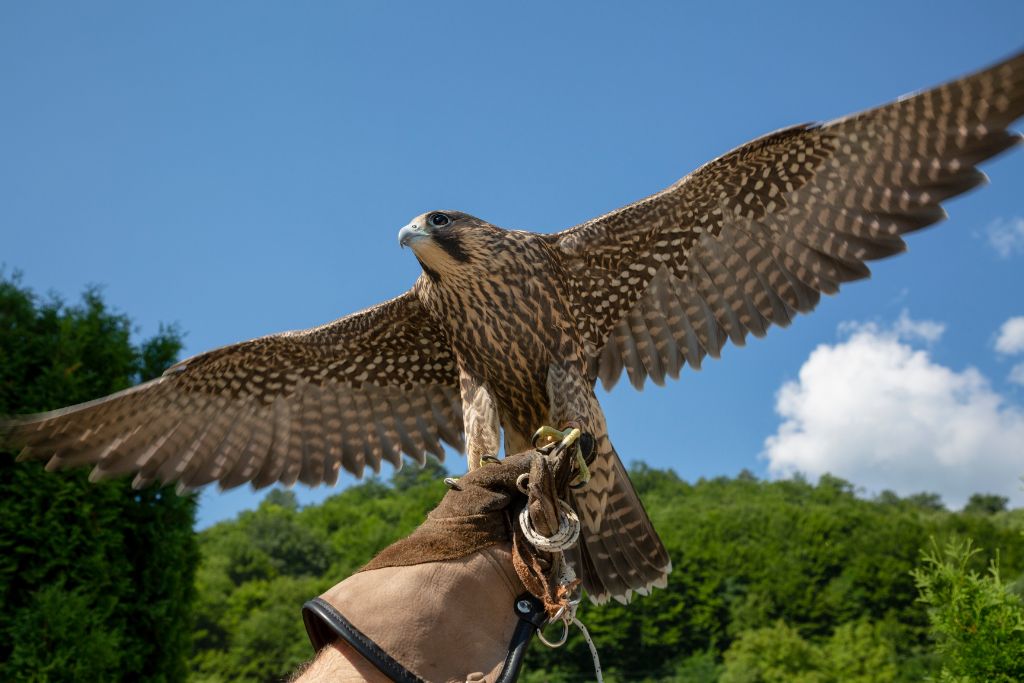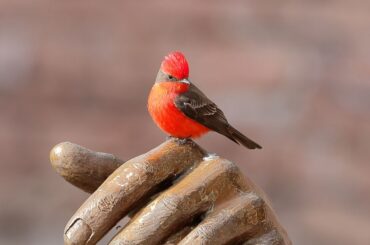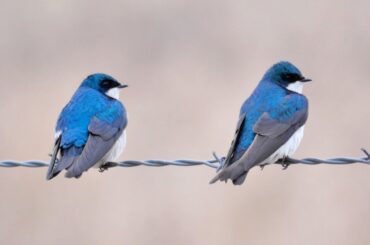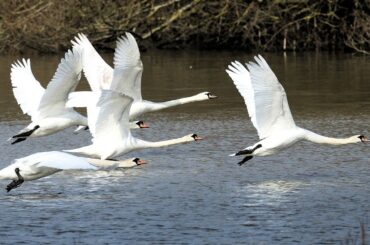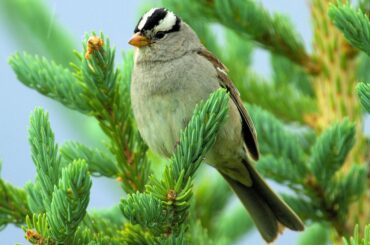When you think of Michigan, do you think of the beautiful falcons that live there? The state’s bird watchers and ecotourists have fallen in love with these magnificent raptors.
This article will delve deeper into the intriguing world of falcons in Michigan, exploring their habitats, behavior, and the significance of conservation efforts in maintaining healthy populations.
What do Falcons Look Like in Michigan?
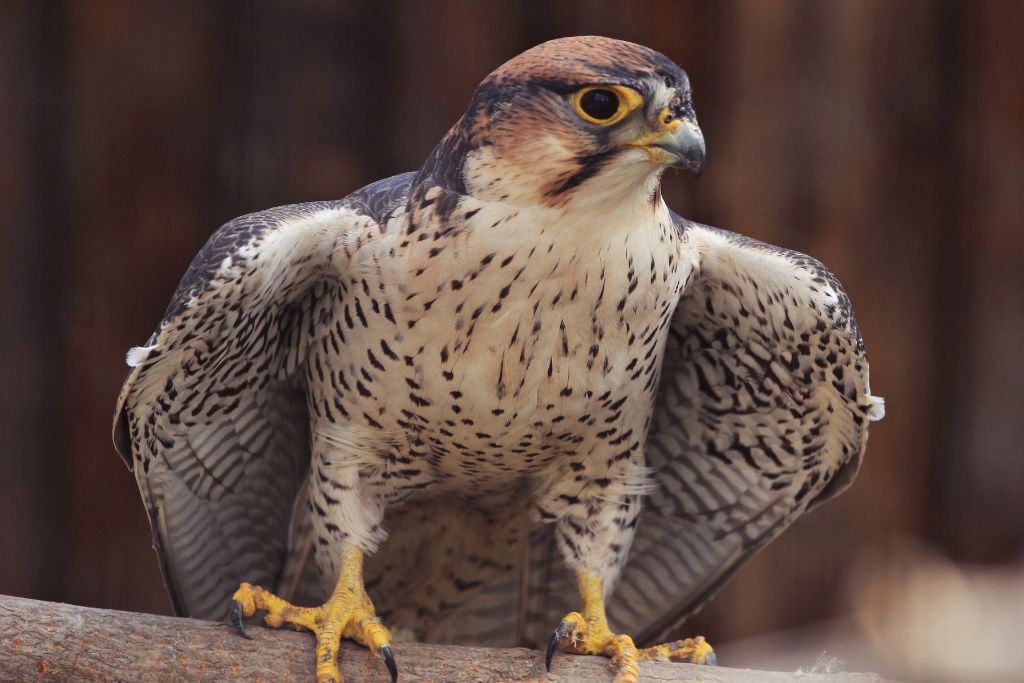
The Michigan falcon is easily recognized due to its unique characteristics. These birds of prey are intermediate in size, with a length of 12 to 18 inches and a wingspan of 2 to 3 feet. Though smaller than eagles, their increased size compared to other birds gives them a distinct advantage in the air.
Falcons of Michigan are visually striking because they combine dark and light colors. Dark brown or grayish brown feathers decorate their backs, while lighter shades of white or buff decorate their bellies.
Some falcons have distinctive markings, including black bars or dots across their bellies and chests. These markings help them blend in with their environments and stay hidden while hunting.
The types of Falcons in Michigan are surprisingly widespread and do well in various settings, from rural to suburban to urban. Cliffs, high structures, and big trees are popular places for them to nest and perch.
Pigeons and sparrows are the most common prey items. They rely extensively on these bird species to provide the nutrition they require and ensure their general survival.
Seeing a peregrine falcon in Michigan dive from above at dizzying speeds or a merlin dart through the air like a flash as it chases prey is a sight to watch.
American Kestrel
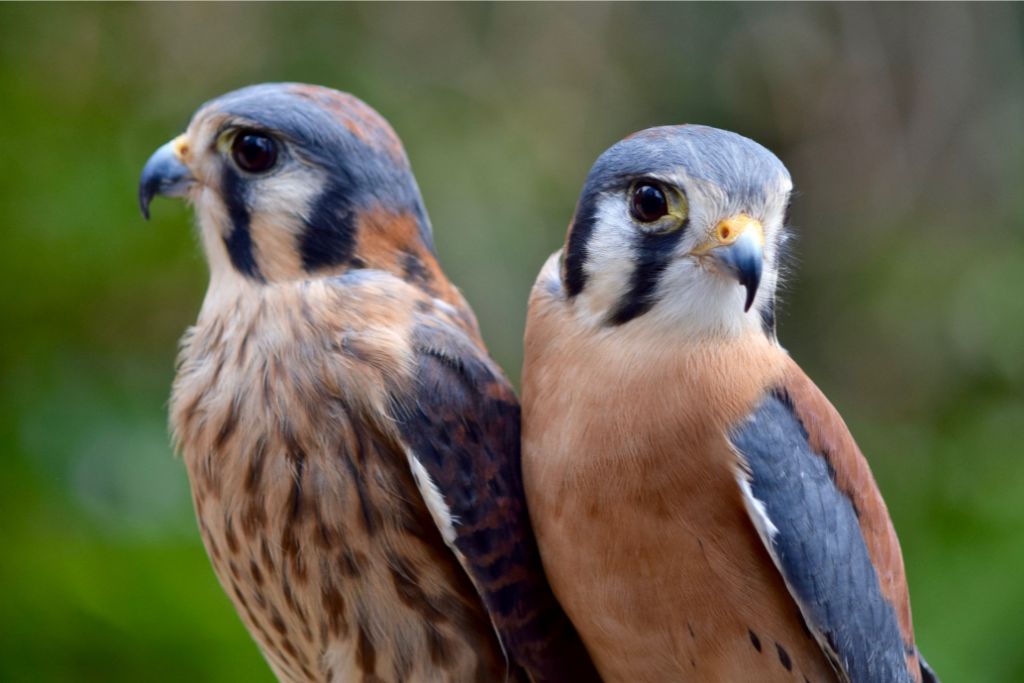
- Kingdom: Animalia
- Phylum: Chordata
- Class: Aves
- Order: Falconiformes
- Genus: Falco
- Species: F. sparverius
The American kestrel (Falco sparverius) is Michigan’s smallest and most colorful falcon. These birds measure about 9 to 12 inches long and have a wingspan of around 20 to 24 inches.
Male Kestrels exhibit vibrant plumage, sporting rusty-red back feathers, blue-gray wings, and a white and black face pattern. Females, on the other hand, have similar patterns but with more brownish tones. Both genders have distinctive dark vertical markings on their cheeks, known as “mustache marks.”
Hunting and perching suit American kestrels. They precisely kill their prey using their sharp, hooked beaks and strong talons. They can see small rodents, insects, and birds from far out.
In Michigan, these falcons are often found in grasslands, farmlands, meadows, and even roads, where they perch on power lines, trees, or telephone poles.
They are known for “kiting,” a unique way of hunting in which they fly in the air while looking for food. They are unique because they can see ultraviolet light, which lets them find rodent urine tracks.
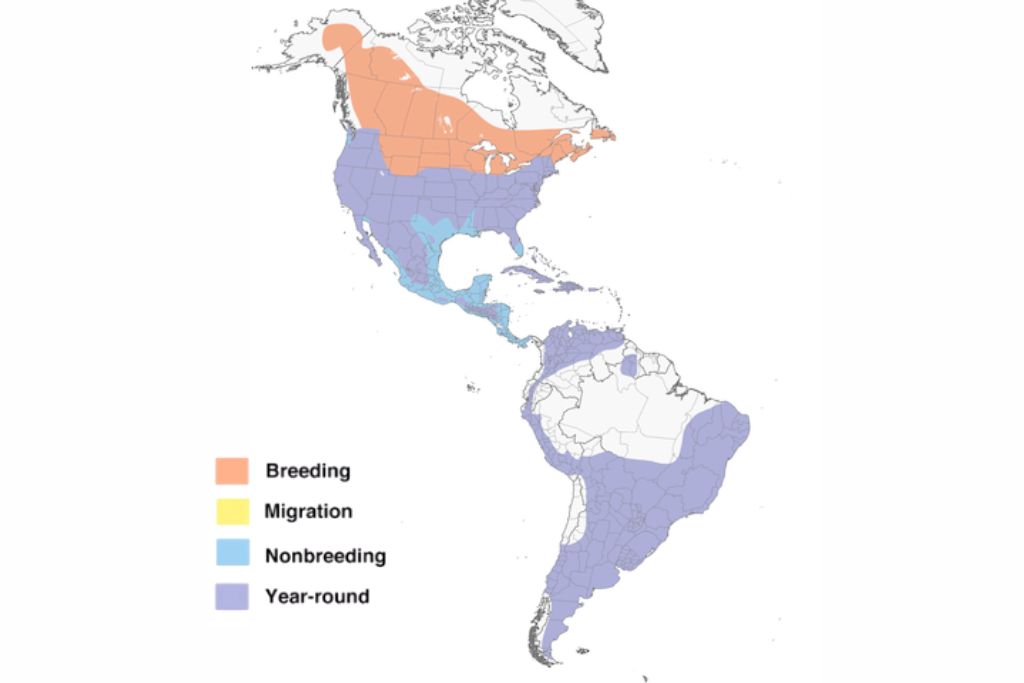
In having excellent eyesight, Kestrels also have a good sense of hearing, which helps them find food hidden in plants. American kestrels need Michigan as a place to nest and rest when they are migrating, so a lot of these exciting falcons can be seen there in the spring and fall.
Merlin
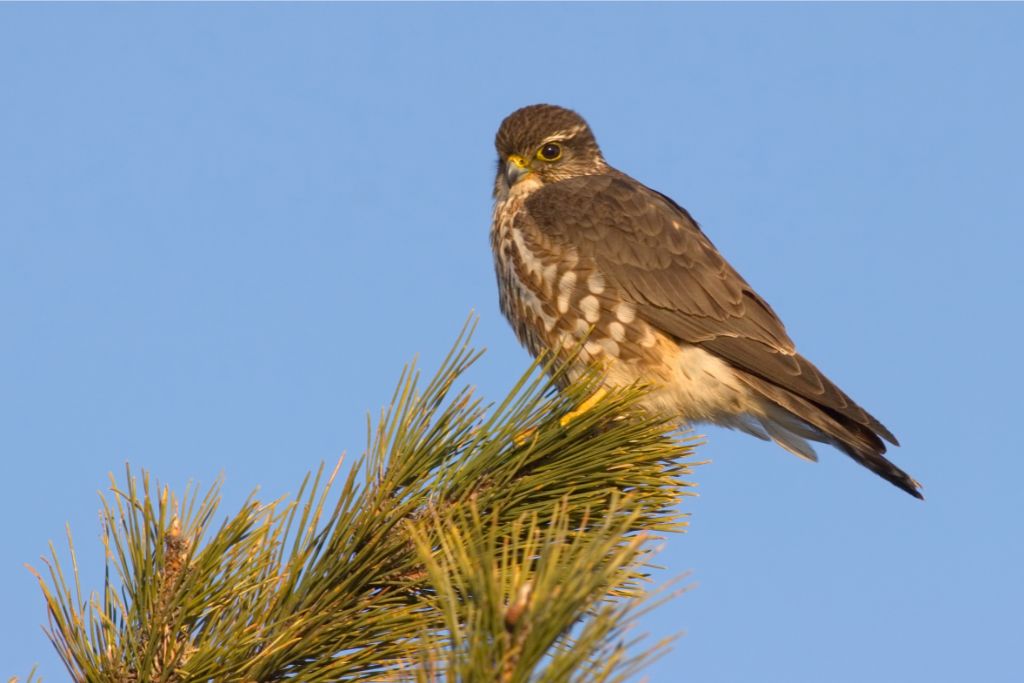
- Kingdom: Animalia
- Phylum: Chordata
- Class: Aves
- Order: Falconiformes
- Genus: Falco
- Species: F. columbarius
The merlin (Falco columbarius) is a small but mighty falcon species found in Michigan. They measure about 9 to 12 inches long and have a wingspan of 20 to 26 inches.
Male merlins have a blue-gray back and reddish-orange breast feathers, while females have a brownish-gray back and streaked breast feathers. They are quick hunters with sharp beaks and strong claws that let them catch flying birds.
While female merlins lay anywhere from 3 to 5 eggs, which are then cared for by both parents for about 28 to 32 days, they feed the chicks until they can fly, generally after 25 to 30 days.
Interesting facts about Merlins include their long-distance migration, with some individuals traveling from Michigan to South America for the winter. They have a rapid wingbeat and can reach up to 30 to 40 miles per hour during their high-speed pursuits.
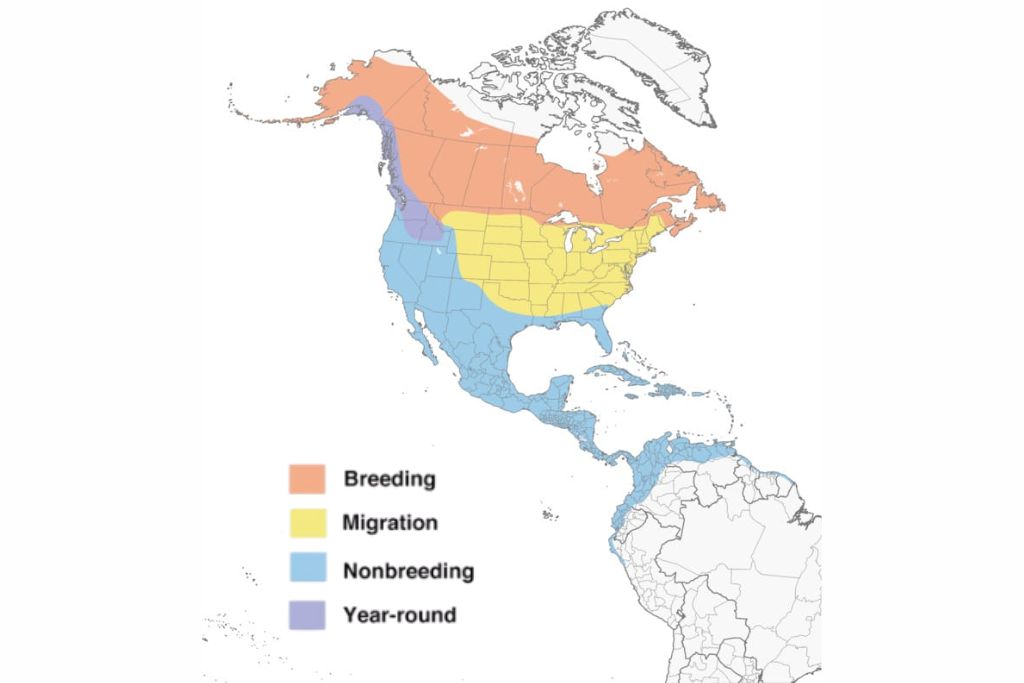
In the wild, the normal lifespan of a Merlin is between 5 and 8 years. Merlins are often seen in Michigan during the breeding season and when moving in the spring and fall. You can spot one in Michigan’s open woods, forest areas, and marshes.
Gyrfalcon
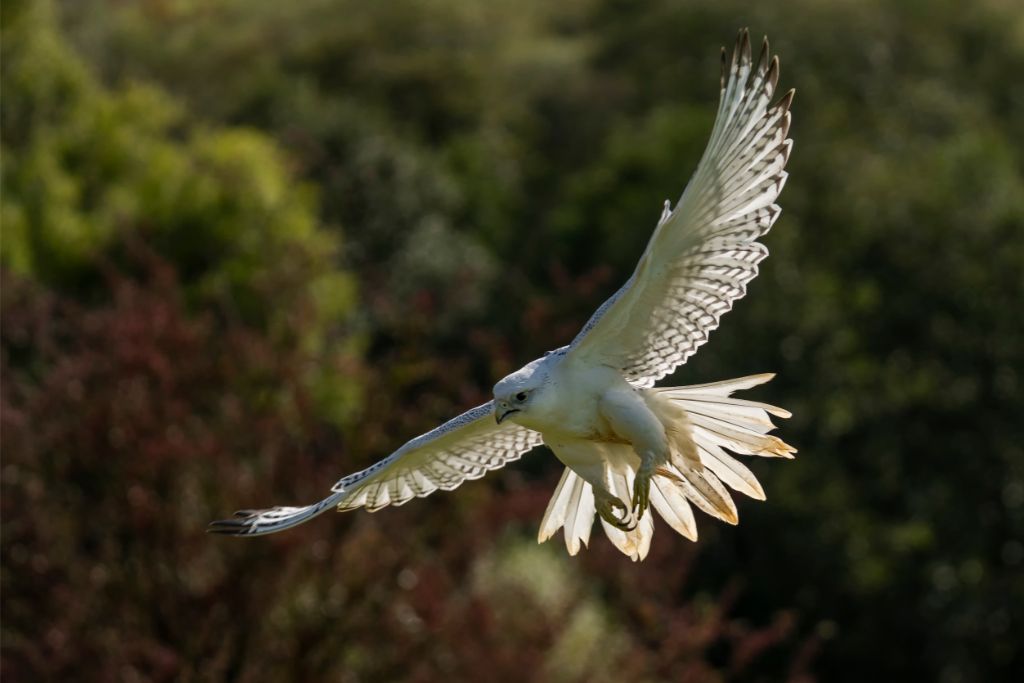
- Kingdom: Animalia
- Phylum: Chordata
- Class: Aves
- Order: Falconiformes
- Genus: Falco
- Species: F. rusticolus
Michigan’s Gyrfalcon (Falco rusticolus) is gorgeous and powerful. One of the world’s largest falcons, these birds are 19 to 25 inches long and 45 to 61 inches wide. Gyrfalcons range from dark gray to virtually pristine white. They have strong bodies, large wings, and curved beaks.
Gyrfalcons are well-suited to their Arctic and sub-Arctic settings. They have thick feathers and a deep layer of down that keep them warm in cold weather.
These falcons are fierce hunters with amazing speed and grace. Most of the time, they eat birds, like ptarmigans and ducks.
Gyrfalcons live in tundra, open taiga woods, and rocky cliffs. Most of the time, they are seen in the Upper Peninsula, especially along the Great Lakes coast.
During courtship, they put on amazing displays of aerial beauty. Gyrfalcons use wood, grass, and feathers to construct their nests on rocks or ledges at great heights. They have a gestation period of 32 to 35 days, during which the female lays 3 to 5 eggs. Both parents take turns caring for the baby falcons during the first 40 to 45 days after they hatch.
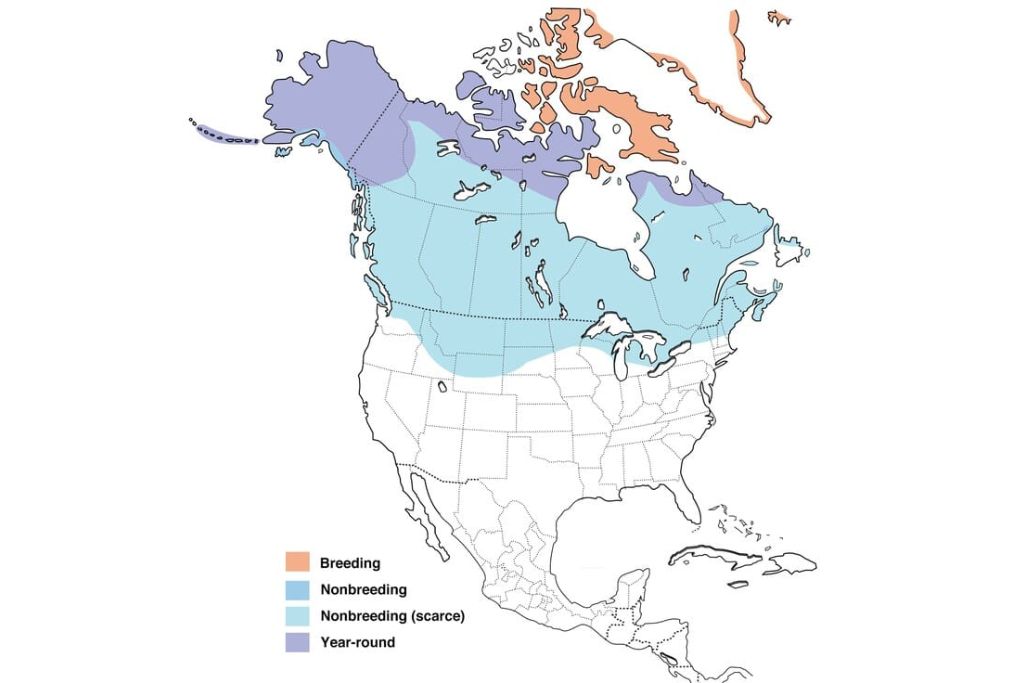
In the sport of falconry, these beautiful birds are highly valued because they are smart, fast, and good at finding their food. Gyrfalcons are seen as powerful and regal in many countries.
Peregrine Falcon
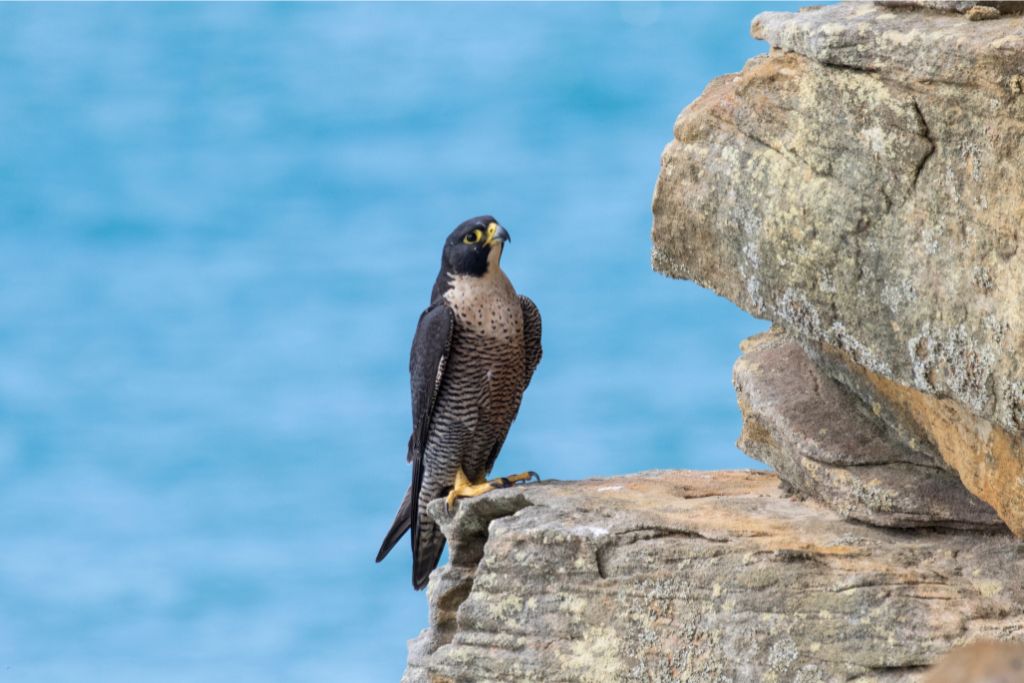
- Kingdom: Animalia
- Phylum: Chordata
- Class: Aves
- Order: Falconiformes
- Genus: Falco
- Species: F. peregrinus
The Peregrine Falcon (Falco peregrinus) is an impressive falcon species in Michigan. These birds possess distinct characteristics that set them apart. Peregrine falcons have a sleek and streamlined body, with a wingspan of 38 to 43 inches.
Males have a blue-gray back and wings, while females have a brownish-gray back and wings. One notable feature of peregrine falcons is their exceptional speed, making them the fastest bird in the world.
This bird species in Michigan have sharp, hooked beaks and powerful talons to capture their prey. These falcons are known for their aerial hunting skills, using their speed and agility to pursue and catch small birds in mid-flight.
Peregrine falcons are versatile in their habitat selection, commonly found in various environments, including coastal areas, cliffs, and urban regions. In Michigan, they are often spotted nesting on tall buildings and bridges.
The Michigan Department of Natural Resources has implemented conservation efforts to support and monitor the peregrine falcon population.
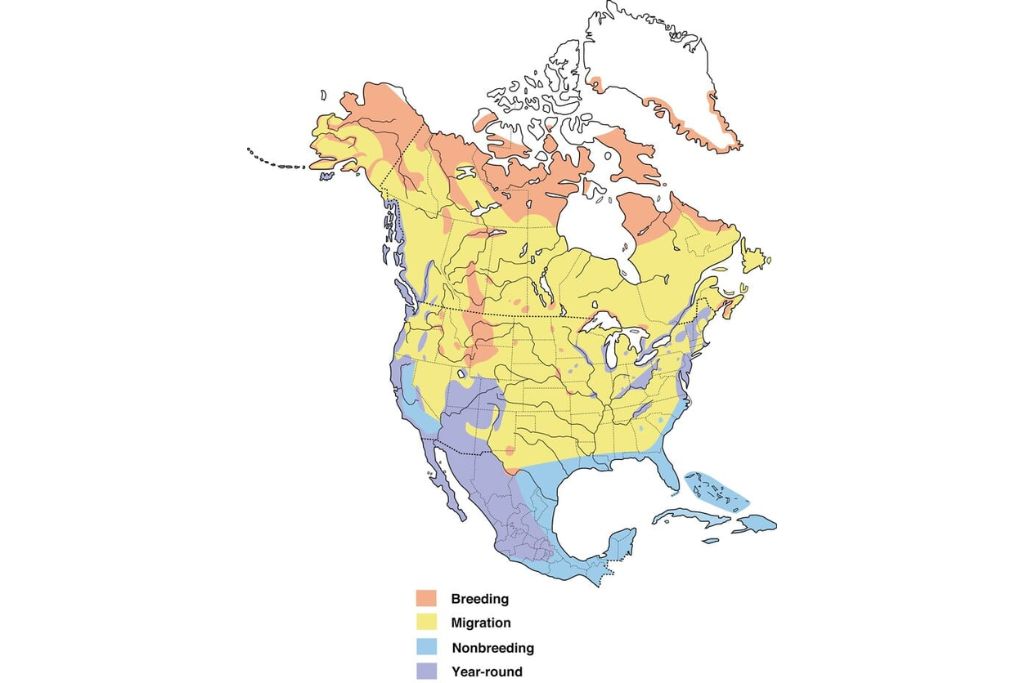
Female peregrines lay 3 to 4 eggs, which both parents incubate for about 29 to 33 days. Once hatched, the chicks are cared for by both parents until they fledge after about 42 to 46 days.
The long lifespan of the peregrine falcon is one of its most remarkable characteristics. These birds have a natural lifespan of 15 years or more. Also fascinating is that they can adapt to city life by making their nests in high places.
When maintaining ecological harmony, small bird populations indicate how well peregrine falcons do their job.
Northern Goshawk
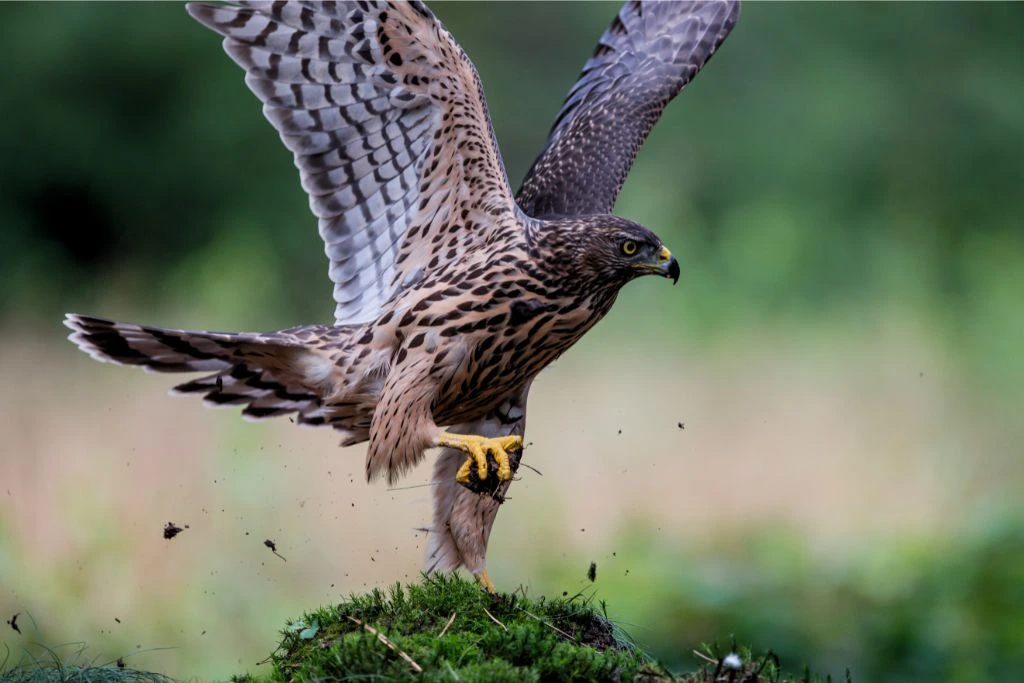
- Kingdom: Animalia
- Phylum: Chordata
- Class: Aves
- Order: Accipitriformes
- Genus: Accipiter
- Species: A. gentilis
The northern goshawk (Accipiter gentilis) is a formidable raptor species found in Michigan. These birds exhibit distinctive characteristics that set them apart. Northern Goshawks are medium to large, measuring around 20 to 26 inches long, with a wingspan of about 40 to 46 inches.
They have short, broad wings and a long tail, ideal for maneuvering through dense forests with agility. Goshawks have a slate-gray to dark brown coloration on their back and wings, while their underparts are lighter with streaks or bars.
Northern goshawks are remarkable forest hunters. They chase food through trees with their muscular legs and sharp talons. These raptors hunt birds and small mammals in deep forests by sneaking up on them. Northern goshawks live in mature forests, especially in Northern Michigan.
Some interesting facts about northern goshawks are that they typically live in the wild for 5 to 10 years. These birds are skilled hunters and use clever techniques when hunting. They often surprise their prey by flying close to the ground and quickly changing direction.
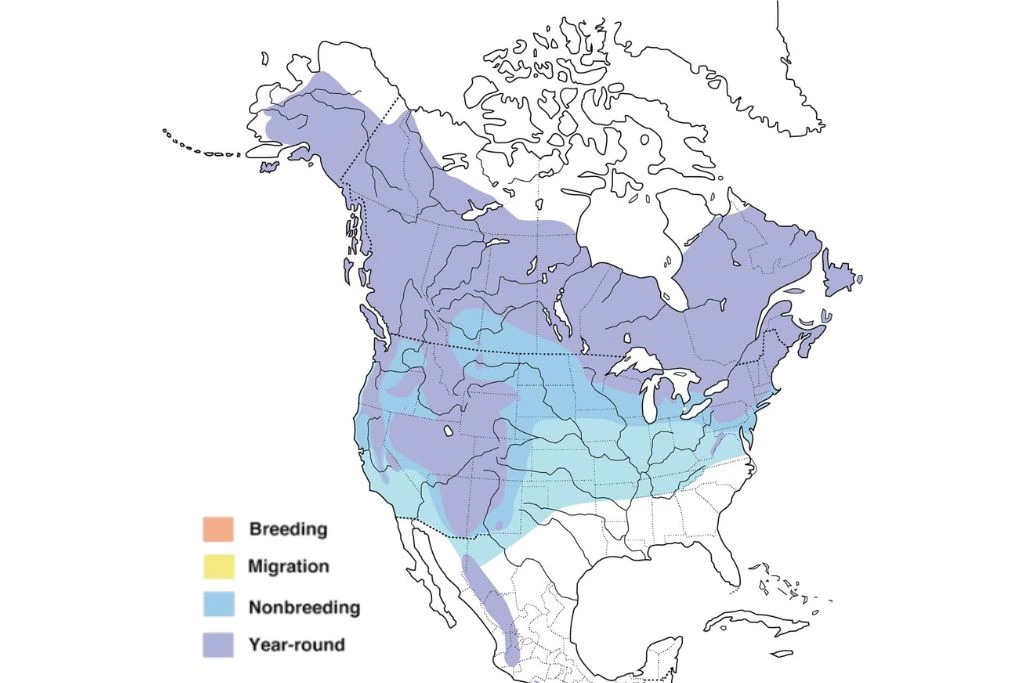
People think that the northern goshawk can show the health of mature woods. Goshawks are a sign that the forest ecosystem is healthy and in order when they are there. These birds are good at hunting and have learned to live well in the woods.
Crested Caracara
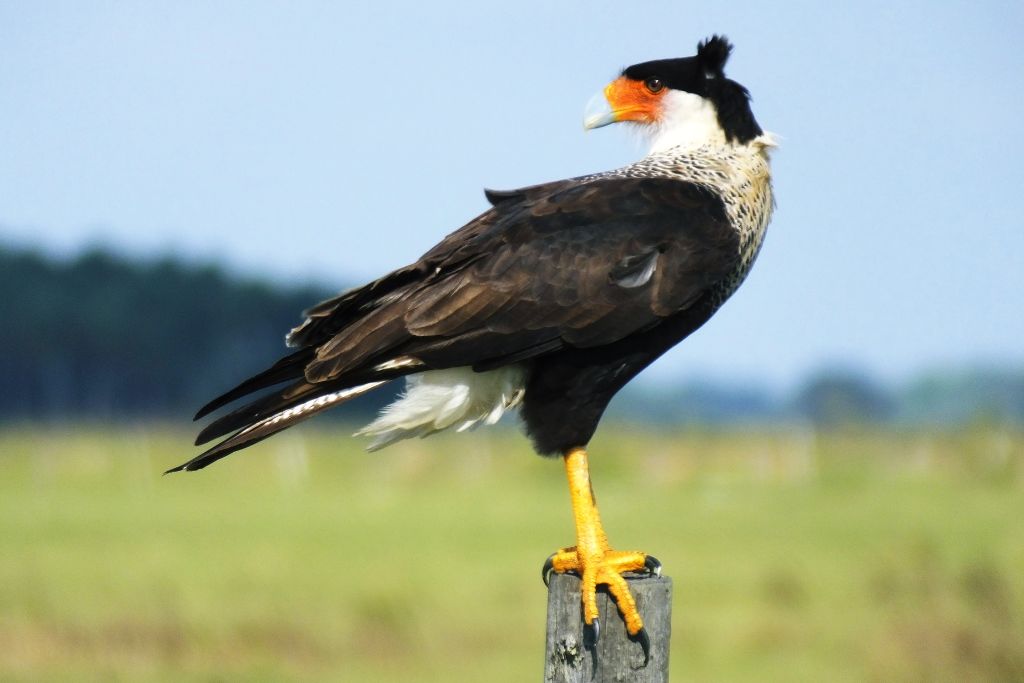
- Kingdom: Animalia
- Phylum: Chordata
- Class: Aves
- Order: Falconiformes
- Genus: Caracara
- Species: C. plancus
Crested caracara (C. plancus) is a unique type of bird of prey that lives in Michigan. These birds have unique traits that make them easy to recognize. Commonly, they are 19 to 23 inches long and 45 to 47 inches wide.
The huge crest on their head gives them their name and distinguishes them. Their neck, breast, and wings are white, contrasting with their black body.
These birds are known for eating roadkill and other animal carcasses.
During migration, Crested Caracaras occasionally visit southern Michigan.
Both males and females actively incubate the 2 to 3 eggs, diligently taking turns for about 30 to 32 days. They both nurture and feed the chicks until they reach around 6 to 7 weeks when the young birds take flight and embark on their independent journeys.
There are many interesting things about the Crested caracara, like how it usually lives for 10 to 15 years in the wild. These birds have a strange habit called “anting,” in which they rub ants on their feathers, possibly to get rid of bugs.
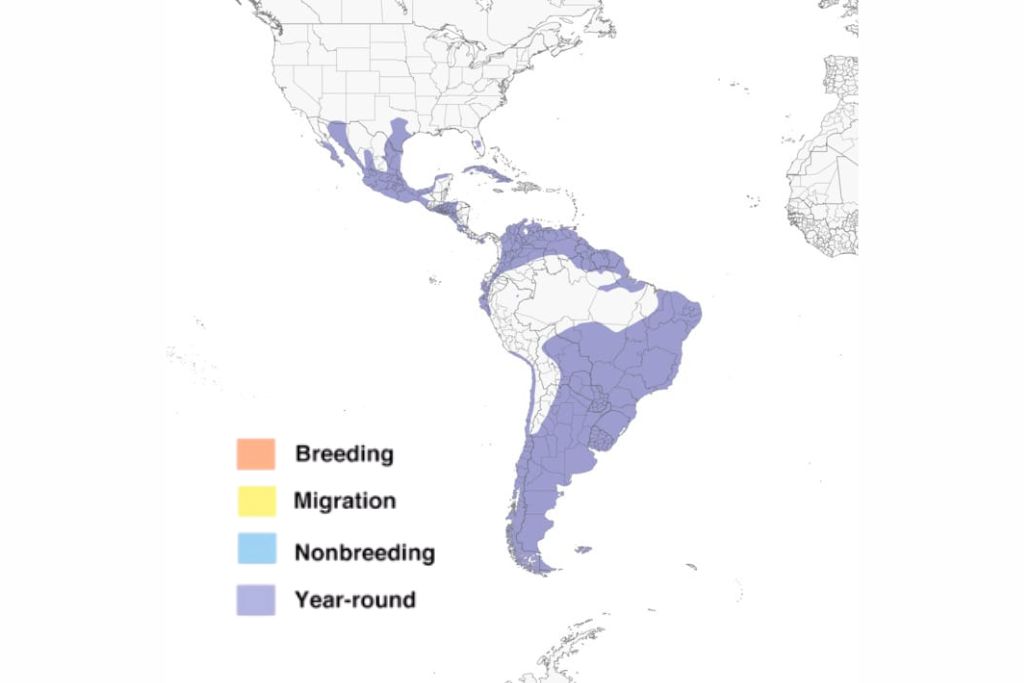
Crested caracaras also have a lot to say with their voices. They make various calls, including some that are loud and screech-like. In many countries, these birds are a sign of strength and resiliency.
Prairie Falcon
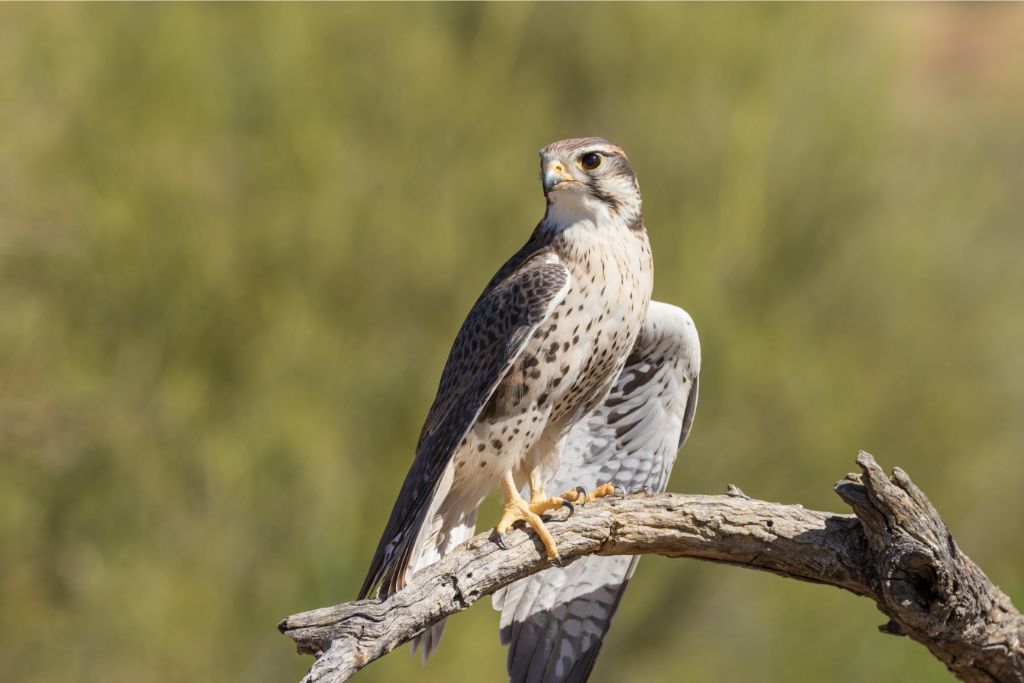
- Kingdom: Animalia
- Phylum: Chordata
- Class: Aves
- Order: Falconiformes
- Genus: Falco
- Species: F. mexicanus
Prairie falcon (B. virginianum), a species of falcon found in North America, possesses unique characteristics and adaptations that make it well-suited for its habitat.
With deeper stripes and a lighter belly, these falcons are brownish-gray. Their bodies range from 14 to 18 inches, and their wingspans are 35 to 43 inches. In grasslands and plains, they use their speed and skill to hunt.
Adapted perfectly to their surroundings, prairie falcons have sharp beaks and powerful talons that help them catch various prey. Their diet consists of small mammals, birds, reptiles, and insects. When hunting, they employ their speed and maneuverability to chase their prey through the air.
While prairie falcons are uncommon in Michigan, you might occasionally spot them in open grasslands and agricultural areas.
Prairie falcons choose nesting sites on cliffs or steep slopes, providing a good view of their surroundings. They form pairs for nesting, and the female lays a clutch of 3 to 5 eggs.
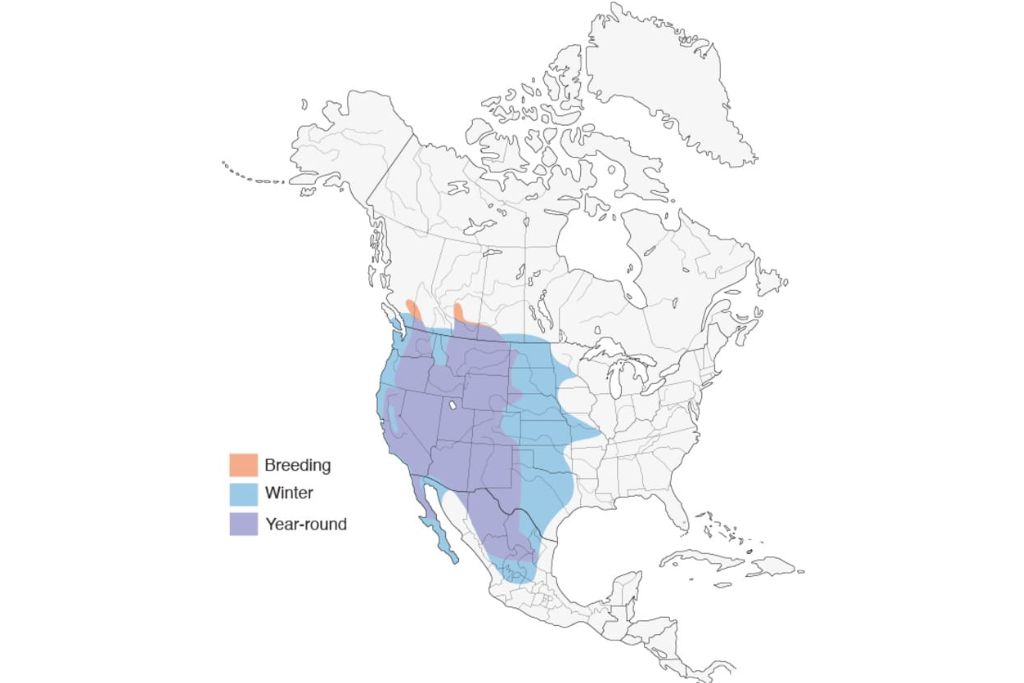
Did you know that Prairie falcons have an average life expectancy of 6 to 10 years in the wild?
In pursuit of prey, they can reach impressive speeds of up to 60 miles per hour! Just imagine the thrill of witnessing a prairie falcon soaring through the sky at such incredible speeds.
FAQs
Are there Falcons in Michigan?
Yes, there are falcons in Michigan.
What Types of Falcons Can Be Found in Michigan?
The types of falcons found in Michigan include the American kestrel, merlin, peregrine falcon, gyrfalcon, northern goshawk, crested caracara, and prairie falcon.
Where Can I Spot Falcons in Michigan?
Falcons can be spotted in various places in Michigan, like open fields, prairies, farmlands, forests, and near cliffs or steep slopes. They make their nests in these habitats. If you want to see them, look for these types of places and keep an eye out for them.
What Are Falcons Known For?
Falcons are known for their speed and how well they can hunt. They are skilled shooters in the air and can reach high speeds as they chase their prey. Falcons are also known for their unique calls and how they have changed to help them live in different places.
What Does It Mean When You See Falcons?
The meaning of seeing falcons can change from culture to culture and person to person. In general, falcons stand for power, speed, and grace. Some may see seeing a hawk as a sign of strength, freedom, or inspiration.

